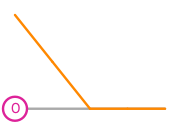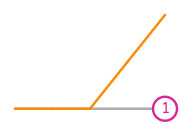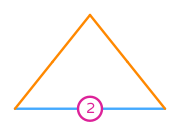an encyclopedia of finite element definitions
Degree 1 P1-iso-P2 on a interval
◀ Back to P1-iso-P2 definition page
- \(R\) is the reference interval. The following numbering of the sub-entities of the reference cell is used:
- \(\mathcal{V}\) is spanned by: \(\begin{cases} 1 - 2 x&\text{in }\operatorname{Interval}(((0,), (1/2,)))\\0&\text{in }\operatorname{Interval}(((1/2,), (1,)))\end{cases}\), \(\begin{cases} 2 x&\text{in }\operatorname{Interval}(((0,), (1/2,)))\\2 - 2 x&\text{in }\operatorname{Interval}(((1/2,), (1,)))\end{cases}\), \(\begin{cases} 0&\text{in }\operatorname{Interval}(((0,), (1/2,)))\\2 x - 1&\text{in }\operatorname{Interval}(((1/2,), (1,)))\end{cases}\)
- \(\mathcal{L}=\{l_0,...,l_{2}\}\)
- Functionals and basis functions:

\(\displaystyle l_{0}:v\mapsto v(0)\)
\(\displaystyle \phi_{0} = \begin{cases} 1 - 2 x&\text{in }\operatorname{Interval}(((0,), (1/2,)))\\0&\text{in }\operatorname{Interval}(((1/2,), (1,)))\end{cases}\)
This DOF is associated with vertex 0 of the reference cell.
\(\displaystyle \phi_{0} = \begin{cases} 1 - 2 x&\text{in }\operatorname{Interval}(((0,), (1/2,)))\\0&\text{in }\operatorname{Interval}(((1/2,), (1,)))\end{cases}\)
This DOF is associated with vertex 0 of the reference cell.
\(\displaystyle l_{1}:v\mapsto v(1)\)
\(\displaystyle \phi_{1} = \begin{cases} 0&\text{in }\operatorname{Interval}(((0,), (1/2,)))\\2 x - 1&\text{in }\operatorname{Interval}(((1/2,), (1,)))\end{cases}\)
This DOF is associated with vertex 1 of the reference cell.
\(\displaystyle \phi_{1} = \begin{cases} 0&\text{in }\operatorname{Interval}(((0,), (1/2,)))\\2 x - 1&\text{in }\operatorname{Interval}(((1/2,), (1,)))\end{cases}\)
This DOF is associated with vertex 1 of the reference cell.


